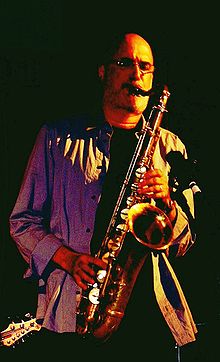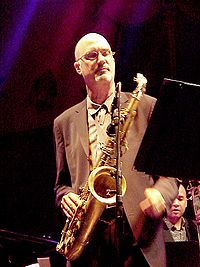- Michael Brecker
-
Michael Brecker 
Michael Brecker in July 2004, performing during the "Jazz for Kerry" benefit concert in Manhattan.Background information Birth name Michael Leonard Brecker Born March 29, 1949
Cheltenham, Pennsylvania, U.S.Died January 13, 2007 (aged 57)
New York City, New York, U.S.Genres Jazz, post-bop,[1][2] jazz fusion, funk, R&B, rock Occupations Saxophonist, composer Instruments Saxophone, EWI Years active 1969–2007 Website http://www.michaelbrecker.com Michael Leonard Brecker (March 29, 1949 – January 13, 2007) was an American jazz saxophonist and composer. Acknowledged as "a quiet, gentle musician widely regarded as the most influential tenor saxophonist since John Coltrane,"[3] he has been awarded 15 Grammy Awards as both performer and composer and was inducted into Down Beat Jazz Hall of Fame in 2007.
Contents
Biography
Born in Philadelphia, Pennsylvania and raised in Cheltenham Township, a local suburb, Michael Brecker was exposed to jazz at an early age by his father, an amateur jazz pianist. He grew up a part of the generation of jazz musicians who saw rock music not as the enemy but as a viable musical option. Brecker began studying clarinet, then moved to alto saxophone in school, eventually settling on the tenor saxophone as his primary instrument. He graduated from Cheltenham High School in 1967 and after only a year at Indiana University, Michael Brecker moved to New York City in 1969 where he carved out a niche for himself as a dynamic and exciting jazz soloist. He first made his mark at age 21 as a member of the jazz-rock band Dreams—a band that included his older brother Randy, trombonist Barry Rogers, drummer Billy Cobham, Jeff Kent and Doug Lubahn. Dreams was short-lived, lasting only a year, but Miles Davis was seen at some gigs prior to his recording Jack Johnson.[4]
Most of Brecker's early work is marked by an approach informed as much by rock guitar as by R&B saxophone. After Dreams, he worked with Horace Silver and then Billy Cobham before once again teaming up with his brother Randy to form the Brecker Brothers. The band followed jazz-rock trends of the time, but with more attention to structured arrangements, a heavier backbeat, and a stronger rock influence. The band stayed together from 1975 to 1982 with consistent success and musicality.
During his career, he was in great demand as a soloist and sideman. He performed with bands which spanned from mainstream jazz to mainstream rock. Altogether, he appeared on over 700 albums, either as a band member or a guest soloist. He put his stamp on numerous pop and rock recordings as a soloist. His featured guest solos with James Taylor and Paul Simon are excellent examples from this body of work. For example, on James Taylor's 1972 album, One Man Dog, Brecker's solo on the track "Don't Let Me Be Lonely Tonight" complements the other acoustic instruments and sparse vocal. Also, on Paul Simon's 1975 album Still Crazy After All These Years, Brecker's solo on the title track is used to a similar effect. His solos are often placed in the bridge, or appended as a coda. This musical structure and instrumentation typifies (and somewhat defines) this jazz-rock fusion style. Other notable collaborations in this genre include work with Steely Dan, Lou Reed, Donald Fagen, Dire Straits, Joni Mitchell, Eric Clapton, John Lennon, Aerosmith, Dan Fogelberg, Frank Sinatra, Frank Zappa, Bruce Springsteen, and Parliament-Funkadelic.
Brecker also recorded or performed with leading jazz figures during his era, including Herbie Hancock, Chick Corea, Chet Baker, George Benson, Quincy Jones, Charles Mingus, Jaco Pastorius, McCoy Tyner, Pat Metheny, Elvin Jones, Claus Ogerman, and many others.
During the early 1980s, he was also a member of NBC’s Saturday Night Live Band. Brecker can be seen in the background sporting shades during Eddie Murphy’s James Brown parody. After a stint co-leading the all-star group Steps Ahead with Mike Mainieri, Brecker finally recorded a solo album in 1987. That eponymously titled debut album marked his return to a more traditional jazz setting, highlighting his compositional talents and featuring the EWI (Electronic Wind Instrument), which Brecker had previously played with Steps Ahead. In 1987 he featured his new solo CD at the JVC Newport Jazz Festival, incorporating the EWI. Referring to the sound that Brecker produced from the EWI, musician and opening act Ruben Riera (flautist, percussionist) (with The Gary Pearson Ensemble) said "it was amazing." He continued to record albums as a leader throughout the 1990s and 2000s, winning multiple Grammy Awards. His solo and group tours consistently sold out top jazz venues in major cities worldwide.
He went on tour in 2001 with a collaborative group, Hancock-Brecker-Hargrove. This tour was dedicated to jazz pioneers John Coltrane and Miles Davis. Brecker paid homage to Coltrane by performing Coltrane's signature piece, "Naima". This composition is a definitive work for tenor sax; its demanding solo enabled Brecker to show his complete mastery of the instrument. The live concert CD from the tour, Directions in Music, won a Grammy in 2003.
While performing at the Mount Fuji Jazz Festival in 2004, Brecker experienced a sharp pain in his back. Shortly thereafter in 2005, he was diagnosed with the blood disorder myelodysplastic syndrome (MDS). Despite a widely publicized worldwide search, Brecker was unable to find a matching stem cell donor. In late 2005, he was the recipient of an experimental partial matching stem cell transplant. By late 2006, he appeared to be recovering, but the experiment proved not to be a cure. He made his final public performance on June 23, 2006, playing with Herbie Hancock at Carnegie Hall.
On January 13, 2007, Michael Brecker died from complications of leukemia in New York City. His funeral was held on January 15, 2007 in Hastings-on-Hudson, NY.
On February 11, 2007, Michael Brecker was awarded two posthumous Grammy awards for his involvement on his brother Randy's 2005 album Some Skunk Funk.
On May 22, 2007, his final recording, Pilgrimage, was released receiving a good critical response. It was recorded in August 2006 with Pat Metheny on guitar, John Patitucci on bass, Jack DeJohnette on drums and Herbie Hancock and Brad Mehldau on piano. Brecker was critically ill when it was recorded but the other musicians involved praised the standard of his musicianship.[5] Brecker was again posthumously nominated and subsequently awarded two additional Grammy Awards for this album in the categories of Best Jazz Instrumental Solo and Best Jazz Instrumental Album, Individual or Group, bringing his Grammy total to 15.
During his career, Brecker played a Selmer Mark VI tenor saxophone using a customized Dave Guardala mouthpiece. Early in his career, he had played a Selmer Super Balanced Action saxophone. His earlier mouthpieces included a metal Dukoff (in the late 70s and early 80s) and a metal Otto Link (in the mid-70s).
More to Live For
The film is the story of three lives, all shaken by cancer and dependent upon the one vital bone marrow match that could save them. Their unrelated paths become connected in a desperate fight for survival and a singular mission: to bring awareness about bone marrow donation to the millions of people who could save a life today. A film of tragedy and loss, strength and hope, “More to Live For” presents the stories of three individuals facing life and death, and their commitment to making a difference. These deeply personal accounts of confronting illness will inspire hope and action, leaving the viewer empowered to become part of the cure.
In the summer of 2004, Brecker was diagnosed with myelodysplastic syndrome (MDS), an early form of leukemia. In need of a bone marrow transplant to save his life, Brecker searched in the International Bone Marrow Registry for a match. This prompted Michael’s wife and manager to organize a series of bone marrow drives throughout the world, including the Red Sea, Monterey, and Newport Jazz Festivals. By going public with his illness, Brecker raised tens of thousands of dollars for testing, and signed up many thousands of donors, but was unable to find a match for himself. "More to Live For" documents Brecker's intense battle with leukemia, and the production of his final recording, "Pilgrimage".
Selected discography
 Michael Brecker in Hamburg (1981)
Michael Brecker in Hamburg (1981)
As leader & co-leader
- 1975 Brecker Bros.
- 1983 Cityscape (Michael Brecker & Claus Ogerman) with Marcus Miller, Eddie Gomez, Steve Gadd, Alex Acuña
- 1983 Steps Ahead with Mike Mainieri, Eddie Gomez, Peter Erskine & Eliane Elias
- 1987 Michael Brecker with Pat Metheny, Kenny Kirkland, Charlie Haden & Jack DeJohnette
- 1990 Now You See It... Now You Don't; Escher Sketch (A Tale Of Two Rhythms) (album)
- 1992 Return Of The Brecker Brothers (Live in Barcelona)
- 2007 Some Skunk Funk with Randy Brecker
As sideman
- 1976 The Main Attraction - Grant Green
- 1976 Jaco Pastorius
- 1977 Ghost Writer (Garland Jeffreys)
- 1978 Zappa in New York
- 1979 Shadows and Light (Joni Mitchell) with Pat Metheny, Jaco Pastorius, Lyle Mays and Don Alias
- 1979 In Out and Around with Mike Nock (p), Mike Brecker (ts) and Al Foster (d)
- 1984 Night - John Abercrombie
- 1985 Mastertouch (Torsten de Winkel (g), with (b), Alphonse Mouzon (dr), Joachim Kühn (p))
- 1996 Across America (Art Garfunkel)
- 1997 West Side Story (Dave Grusin)
- 2001 Hourglass (James Taylor)
- 2002 Rendezvous In New York With Chick Corea's Three Quartets Band
- 2003 Louis Bellson and His Big Band with Michael Brecker, Randy Brecker, Herb Geller, Benny Bailey, Howard Johnson, and Lew Soloff[6]
- 2004 Live from the Village Vanguard, Vol. 3 with the John Abercrombie Quartet
- 2004 Horacio Hernandez: Live at the Modern Drummer Festival with Marc Quinones, Michael Brecker, John Patitucci, and Hilario Duran
- 2007 Gil Evans and His Orchestra with Gil Evans, Randy Brecker, Michael Brecker, Lew Soloff, Herb Geller, Mike Mainieri, Howard Johnson and Billy Cobham[7]
References
- ^ http://culturecatch.com/music/michael_brecker_obit
- ^ http://webcache.googleusercontent.com/search?q=cache:F8N7KG73LVQJ:jazzbonotes.com/reviews/directions-in-music-michael-brecker-herbie-hancock-roy-hargrove/+michael+brecker+post+bop&cd=21&hl=en&ct=clnk&gl=us&client=firefox-a
- ^ Associated Press "Saxophonist Complete Final Pilgrimage" May 24, 2007
- ^ http://www.jazz-rock.com/artists-MB.html
- ^ New York Times "A Jazzman’s Farewell Album, All Heart and Soul" June 2, 2007
- ^ VIEW DVD Listing
- ^ VIEW DVD Listing
External links
- Official site
- Live recordings
- Complete Discography
- Lucky Link To Old Site
- The Independent - Obituary
Michael Brecker (discography) As leader Pilgrimage · Wide Angles · Nearness of You · Time Is of the Essence · Two Blocks from the Edge · Tales from the Hudson · Now You See It... Now You Don't · Don't Try This at Home · Michael Brecker · Directions in Music: Live at Massey Hall · Gathering of Spirits · CityscapeSteps Ahead Live in Tokyo · Magnetic · Modern Times · Steps Ahead · Paradox · Step By Step · Smokin' In the PitBrecker Brothers Score · East River · Out of the Loop · Return of the Brecker Brothers · Straphangin' · Detente · Heavy Metal Be-Bop · Blue Montreux · Don't Stop the Music · Back To Back · The Brecker Brothers · The Collection, Vol. 1 · The Collection, Vol. 2Dreams Dreams (1970) · Imagine My Surprise (1971)Players Association Born to Dance (1977) · Turn The Music Up (1978)Categories:- 1949 births
- 2007 deaths
- People from Montgomery County, Pennsylvania
- American funk musicians
- Post-bop saxophonists
- Mainstream jazz saxophonists
- Jazz fusion saxophonists
- American jazz saxophonists
- Grammy Award winners
- Deaths from leukemia
- Musicians from Philadelphia, Pennsylvania
- P-Funk members
- Saturday Night Live Band members
- Jazz tenor saxophonists
Wikimedia Foundation. 2010.

